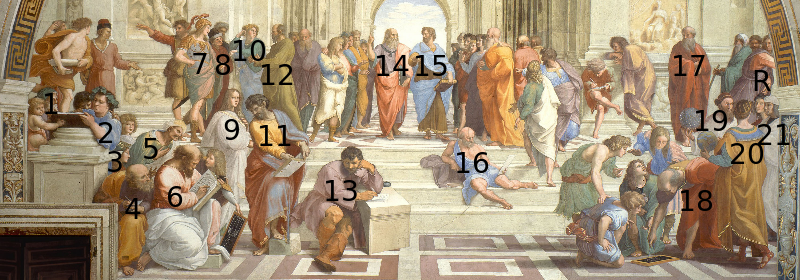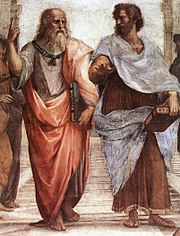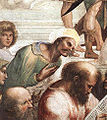The School of Athens
From Wikipedia, the free encyclopedia
 |
| The School of Athens |
| Raphael, 1509–1510 |
| Fresco, 500 × 770 cm |
| Vatican City, Apostolic Palace |
The School of Athens, or Scuola di Atene in Italian, is one of the most famous paintings by the Italian Renaissance artist Raphael. It was painted between 1510 and 1511 as a part of Raphael's commission to decorate with frescoes the rooms now known as the Stanze di Raffaello, in the Apostolic Palace in the Vatican. The Stanza della Segnatura was the first of the rooms to be decorated, and The School of Athens the second painting to be finished there, after La Disputà, on the opposite wall. The picture has long been seen as "Raphael's masterpiece and the perfect embodiment of the classical spirit of the High Renaissance."[1]
Contents |
[edit] Program, subject, figure identifications, interpretations
The title "School of Athens" is an old tour-book’s invention, which tends to obscure the painting’s immediate context and meaning. It is actually one of a group on the four walls of the Stanza (those on either side centrally interrupted by windows) that depict distinct themes of knowledge. Each theme is identified above by a separate tondo containing a majestic female figure seated in the clouds, with putti bearing the phrases: “Seek Knowledge of Causes”, “Divine Inspiration”, “Knowledge of Things Divine” (Disputà), “To Each What Is Due”. Accordingly, the figures on the walls below exemplify Philosophy, Poetry (including Music), Theology, Law. [2] The “School” is therefore actually "Philosophy",[3] and its overhead tondo-label, “Causarum Cognitio” tells us what kind, as it appears to echo Aristotle’s emphasis on wisdom as knowing why, hence knowing the causes, in Metaphysics Book I and Physics Book II. Indeed, Aristotle appears to be the central figure in the scene below. However all the philosophers depicted sought to understand through knowledge of first causes. Many lived before Plato and Aristotle, hardly a third were Athenians, and the architecture is Roman, not Greek.
Commentators have suggested that nearly every great Greek philosopher can be found within the painting, but determining which are depicted is difficult, since Raphael made no designations outside possible likenesses, and no contemporary documents explain the painting.[4] Compounding the problem, Raphael had to invent a system of iconography to allude to various philosophers for whom there were no traditional visual types. For example, while the Socrates figure is immediately recognizable from Classical busts, the alleged Epicurus is far removed from the standard type for that philosopher.[4][1] Nevertheless, there is widespread agreement on the identity of certain figures within the painting.[4] Aside from the identities of the philosophers shown, many aspects of the fresco have been interpreted, but few such interpretations are generally accepted among scholars. The popular idea that the rhetorical gestures of Plato and Aristotle are kinds of pointing (to the heavens, and down to earth) is a likely reading. However Plato’s Timaeus – which is the book Raphael places in his hand – was a sophisticated treatment of space, time and change, including the Earth, which guided mathematical sciences for over a millennium. Aristotle, with his four elements theory, held that all change on Earth was owing to the motions of the heavens. In the painting Aristotle carries his Ethics, which he denied could be a scientific study.
It is not established how much the young Raphael knew of ancient philosophy, what guidance he might have had from people such as Bramante, or what detailed program may have been dictated by the Papal sponsor. Heinrich Wölfflin observed that "it is quite wrong to attempt interpretations of the School of Athens as an esoteric treatise ... The all-important thing was the artistic motive which expressed a physical or spiritual state, and the name of the person was a matter of indifference" in Raphael's time.[5] What is evident is Raphael's artistry in orchestrating a beautiful space, continuous with that of viewers in the Stanza, in which a great variety of human figures, each one expressing "mental states by physical actions", interact, and are grouped in a "polyphony" unlike anything in earlier art, in the ongoing dialogue of Philosophy.[6]
[edit] The figures
The identity of some of the philosophers in the picture, such as Plato or Aristotle, is uncontroversial. But scholars disagree on many of the other figures, some of whom have double identities as ancients and as figures contemporary to Raphael. The extent of double portrayals is uncertain although, for example, that Michelangelo is portrayed (no. 13 below) is generally accepted.[7] According to Lahanas,[8] they are usually identified as follows:
1: Zeno of Citium[9] 2: Epicurus 3: Federico II of Mantua? 4: Anicius Manlius Severinus Boethius or Anaximander or Empedocles? 5: Averroes 6: Pythagoras 7: Alcibiades or Alexander the Great? 8: Antisthenes or Xenophon? 9: Hypatia (Francesco Maria della Rovere or Raphael's mistress Margherita) 10: Aeschines or Xenophon? 11: Parmenides? 12: Socrates 13: Heraclitus (Michelangelo) 14: Plato holding the Timaeus 15: Aristotle holding the Ethics 16: Diogenes of Sinope? 17: Plotinus? 18: Euclid or Archimedes with students (Bramante)? 19: Strabo or Zoroaster? (Baldassare Castiglione or Pietro Bembo) 20: Ptolemy? R: Apelles (Raphael) 21: Protogenes (Il Sodoma, Perugino or Timoteo Viti)[10]
[edit] Central figures (14 and 15)
In the center of the fresco, at its architecture's central vanishing point, are the two undisputed main subjects: Plato on the left and Aristotle, his student, on the right. Both figures hold modern, bound copies of their books in their left hands, while gesturing with their right. Plato holds Timaeus, Aristotle his Nicomachean Ethics. Plato is depicted as old, grey, wise-looking, bare-foot. By contrast Aristotle, slightly ahead of him, is in mature manhood, handsome, well-shod and dressed, with gold, and the youth about them seem to look his way. In addition, these two central figures gesture along different dimensions: Plato vertically, upward along the picture-plane, into the beautiful vault above; Aristotle on the horizontal plan at right-angles to the picture-plane (hence in strong foreshortening), initiating a powerful flow of space toward viewers. Their gestures indicate central aspects of their philosophies. Each philosopher is symbolically indicating that which they hold to be the truest reality. Plato's upward motion represents his Theory of Forms and an emphasis on universals, while Aristotle motions downward, indicating his strongly empiricist views, and an emphasis on the particular.
[edit] The setting
The building is in the shape of a Greek cross, which some have suggested was intended to show a harmony between pagan philosophy and Christian theology[1] (see Christianity and Paganism and Christian philosophy). The architecture of the building was inspired by the work of Bramante, who, according to Vasari, helped Raphael with the architecture in the picture.[1] Some have suggested that the building itself was intended to be an advance view of St. Peter's Basilica.[1]
There are two sculptures in the background. The one on the left is the god Apollo, god of the Sun, archery and music, holding a lyre.[1] The sculpture on the right is Athena, goddess of wisdom, in her Roman guise as Minerva.[1]
[edit] Reproductions
The Victoria and Albert Museum has a rectangular version over 4 metres by 8 metres in size, painted on canvas, dated 1755 by Anton Raphael Mengs on display in the eastern Cast Court.[11]
A reproduction of the fresco can be seen in the auditorium of Old Cabell Hall at the University of Virginia. Produced in 1900 by George W. Breck to replace an older reproduction that was destroyed in a fire in 1895, it is four inches off scale from the original, because the Vatican would not allow identical reproductions of its art works.[12]
Other reproductions are: by Neide, in Königsberg Cathedral, Kaliningrad,[13] in the University of North Carolina at Asheville's Highsmith University Student Union, and a recent one in the seminar room at Baylor University's Brooks College.
More recently the image was used by the band Guns N' Roses for their 1991 albums Use Your Illusion I and Use Your Illusion II Extracts of the image, chiefly the two figures to the left of Plotinus (figure 17), were extracted by New York artist Mark Kostabi for the cover art.
[edit] In popular culture
In Resident Evil 4, the painting can be seen in one of the rooms inside Ramon Salizar's castle.
[edit] Gallery
|
Averroes and Pythagoras |
|||
|
Alcibiades or Alexander the Great and Antisthenes or Xenophon |
|||
|
Bramante as Euclid or Archimedes |
Strabo or Zoroaster, Ptolemy, Raphael as Apelles and Perugino or Timoteo Viti as Protogenes |
Cover of Guns n' Roses album Use Your Illusion I and Use Your Illusion II |
[edit] References
- ^ a b c d e f g History of Art: The Western Tradition By Horst Woldemar Janson, Anthony F. Janson
- ^ See Giorgio Vasari, "Raphael of Urbino", in Lives of the Artists, vol. I. For further clarification, and an introduction to more subtle interpretations, see E. H. Gombrich, “Raphael’s Stanza della Segnatura and the Nature of Its Symbolism”, in Symbolic Images: Studies in the Art of the Renaissance (London: Phaidon, 1975).
- ^ Heinrich Wölfflin, Classic Art: An Introduction to the Italian Renaissance (London: Phaidon, 2d edn. 1953), p. 93
- ^ a b c Daniel Orth Bell, New identifications in Raphael's 'School of Athens.' Art Bulletin, Dec. 1995.
- ^ Wōlfflin, p. 88.
- ^ Wōlfflin, pp. 94f.
- ^ Vasari mentions portraits of Federico II of Mantua, Bramante, and Raphael himself: Giorgio Vasari, Lives of the Artists, v. I, sel. & transl. by George Bull (London: Penguin, 1965), p. 292.
- ^ The School of Athens, "Who is Who?" by Michael Lahanas
- ^ "Zeno the Stoic and Epicurus are behind Averroes." Laurie Adams, (2001), Italian Renaissance Art, page 346. Perseus Books.
- ^ The interpretation of this figure as Sodoma is probably in error as Sodoma was 33 at the time of painting, while Raphael's teacher, Perugino, was a renowned painter and aged about 60 at the time of this painting, consistent with the image. Timoteo Viti is another plausible candidate.
- ^ V&A Museum: Copy of Raphael's School of Athens in the Vatican
- ^ Information on Old Cabell Hall from University of Virginia
- ^ Northern Germany: As Far as the Bavarian and Austrian Frontiers, Baedeker, 1890, p. 247.
[edit] External links
| Wikimedia Commons has media related to: The School of Athens |
- The School of Athens at the Web Gallery of Art
- The School of Athens (interactive map)
- The School of Athens (interactive map)
- The School of Athens — original cartoon at the Ambrosiana Gallery, Milan
- The School of Athens reproduction at UNC Asheville
- BBC Radio 4 discussion about the significance of this picture in the programme "In Our Time" with Melvyn Bragg.




















